Release date: 2015-10-30 The development and clinical application of POCT has a wide range of influences, and it has never been seen before. As evidence-based medicine says, "the development of experimental diagnostics not only improves the diagnostic level of the disease, but can even change the treatment plan and improve the therapeutic effect." POCT sees it as a new revolution in diagnostic technology and a huge challenge to traditional testing. 1 Revolution in the diagnostic process Testing has become an indispensable basis for clinical evidence-based diagnosis and treatment. From the time a doctor issues a test sheet to getting a report, it must go through more than ten steps. The emergency test can take up to half an hour to an hour. The daily test should be one day or several. It takes a long time to get the report, and the feedback time is very long. As a central laboratory, a large number of patients and a batch of specimens must do so. It is impossible to omit any step. Some research has been done on the issue of TAT (the turnaround time for specimen collection, transshipment, processing, and analysis). TAT actually includes three periods before, during and after analysis. In fact, the time in analysis is the least, and a large amount of time is consumed before and after analysis, and the chance of errors in the transmission of samples after leaving the patient site is gradually increased. Therefore, it is still difficult to achieve the purpose of STAT (turnaround time for collection, transfer, processing and analysis of emergency specimens) by simply accelerating the analysis technique and keeping the process unchanged. The reason why POCT can meet the requirements of STAT is not only because the analysis method is simple, fast and correct, but also because it is on-site analysis, which greatly reduces the sample transfer process (see Figure 1), which shortens the reporting time and reduces the error. Opportunity can be said to be a personalized service. It is especially effective in emergency rescue and differential diagnosis. For example, the use of cardiac markers to determine myocardial infarction and to avoid missed diagnosis of myocardial infarction may lead to life-threatening. Non-infarcted patients do not need to be hospitalized, so as not to cause human strain, waste health resources, and increase medical expenses. It can be said that in the twinkling of an eye, life is a must! Is the identification of patients with syncope low blood sugar or high blood sugar? Such as the immediate electrolyte determination of critically ill patients; PT and APTT in patients with cardiac surgery and pulmonary embolism; for example, children with fever use CRP to distinguish between bacterial and viral infections, such as the identification of bacterial infections by gene chips in patients with ineffective anti-inflammatory treatments, etc. Lift. This feature can also be used in specialist outpatient clinics, such as HCG and LH testing in obstetrics and gynaecology clinics, HIV, gonococcal and syphilis testing in STD clinics; blood glucose, glycosylated hemoglobin and urine microalbumin testing in endocrinology clinics; BNP, Myo, CK-Mbmass, cTn-I test... In order to observe the effect, it is generally necessary to report the patient, register, see a doctor, open a bill, fasting blood, and report for several days, then register and then see the doctor, but now in the clinic The test immediately improved the efficiency of diagnosis and treatment and facilitated the patient. This feature is also widely used in customs, anti-drug food quarantine and even on the battlefield. 2 changes in the way of treatment Going to the hospital to see a doctor is essentially two big pieces, one is to see if there is a disease, it is screening; the other is really sick, need to be healed, is therapeutic. Traditional medical institutions are divided into three levels (referred to as different tertiary cares in foreign countries), and now they are influxed to tertiary hospitals regardless of illness or illness, or seek medical treatment step by step (previously need referral), resulting in busy hospitals at all levels. Uneven, health resources are extremely wasteful. In fact, half of the patients are going to ask for illness and check the disease. Most of the patients are common or frequently-occurring, and there is no need to go to a large tertiary hospital. Crowded, excessive waste of health resources. Most screening, identification, and follow-up work, if properly methoded and reasonably scientific, can be resolved in the primary health system and in the vicinity of the patient. Foreign studies on health economics and utilization of health resources have found that in the same region, the same population, the original large and medium-sized hospitals, a small number of community health centers are concentrated as a large general hospital (responsible for the troubles and serious illness of the entire area residents) The diagnosis and treatment of patients and a number of community health clinics (responsible for common diseases, frequently-occurring diagnosis and treatment, and residents' health care and follow-up, nursing, and emergency treatment) not only save money, but also benefit more residents and improve their health. Of course, the level of community hospitals should be considerably improved. Among them, POCT will play a major role in changing the status of “getting sick and taking medicineâ€, but using POCT, whichever is based on data, also implements the medical practice model. 3 Great challenge to traditional inspection Professor Yang Zhenhua, a famous Chinese tester, believes that “the future test will be closer to patients and distributed throughout the hospital and community clinics. In the United States, up to 80% of laboratory work in the near future will be done on instruments that are only a few steps away from the patient. The central laboratory will still exist, responsible for processing and analyzing specimens that cannot be carried out by bedside instruments.†Another well-known testing expert, Professor Cong Yulong, believes that “POCT should reach 70-80% of the inspections in the next 5-10 years, and the basic changes will be made. The current laboratory medical model; of course, the central laboratory should also exist at the same time, mainly to carry out some complicated experiments; when the cost is further reduced, the development of POCT will reach a peak, and we are currently in the process of being changed." China's laboratory or central laboratory is completely independent from the patient and the site, and each sub-professional clinical, chemical, immune, microbiological, endocrine, etc. are relatively independent in terms of personnel, space and management to form a so-called box-like laboratory structure ( Boxlike struCture in laboratory organization). With the development of POCT, the location of the test will be transferred to the ward, outpatient, emergency department, intensive care unit, operating room, and closer to the patient. The share of work will be redistributed, and POCTs that are only partially or occasionally used will be the protagonists of clinical testing. Large-scale automation equipment has become a means of solving problems and filling up the gaps. Therefore, this actually contains a profound change in laboratory medicine. The existing organization, management mode, and operating procedures will change accordingly. With the advancement of biotechnology, medical diagnosis is bound to move toward a more convenient, more sensitive, and more accurate direction. The rise of POCT will inevitably bring revolution to the way of treatment and medical behavior. Source: Mingde Bio Nootropics powder or Nootropics, are a diverse group of cognitively enhancing compounds that are classified as lassi, plant, Vitamin and fuel best nootropic powder,nootropic powder to buy,buy Nootropic Powder Shaanxi YXchuang Biotechnology Co., Ltd , https://www.peptidenootropics.com


I. Lassie drugs to promote wisdom
Rasciates are based on the compound piracetam and tend to work by enhancing the corpus callosum (the brain region that connects the two hemispheres), which can positively affect creativity and speech, acting as a glutamate or AMPA regulator (a subclass of neural receptors involved in learning and memory), brain circulation, brain metabolism, and more.
Lassi is the first class of psychotropic drugs that have been studied based on the naturally occurring amino acid Pyroglutamate (5-oxopyrrolidine-2-carboxylicacid). Most of them work by using glutamate receptors as agonists (compounds that mimic or enhance receptor activity) to enhance and enhance cognitive function. They are non-toxic, safe and do not have any addictive effects.
Piracetam, known chemically as 2-oxo-1-Pyrrolidineacetamide, is the most popular of the rascicidal drugs. Piracetam is known as nootropil in other countries. Piracetam is water soluble and is the best Nootropics studied. Piracetam is used in more than 100 countries and has been shown to improve articulation, memory, concentration, overall cognition and more.
Anisetan (anethacetam) is a fat-soluble form of piracetam, which is known in some countries as Ampamet. It's fat-soluble, and it's an ampakine drug (a class of compounds being developed by DARPA to create mind-enhancing super-soldiers).
NeuroPEPT, chemically known as n-phenylacetyl-L-Prolylglycineethylester, is a novel aminate glycine and a precursor of a naturally occurring peptide in the human brain. It is 1000 times more effective than piracetam and has high bioavailability. It is considered to be the third generation of lasciform nootropics.
2. Plant drugs promoting wisdom
These compounds are found in plants (or produced by plant compounds) to actively support cognitive or emotional health. Huperzine A (L-hupezine) is a common example of a plant nootropics. Huperzine A is an alkaloid extracted from the endemic Chinese plant Huperzine. Studies around the world have found that huperzine A can enhance memory, improve memory impairment, improve the efficiency of mental activities, senile memory decline and alzheimer's disease, adolescent learning disability and memory enhancement have significant improvement effect.
Three, vitamin drugs to promote wisdom
These compounds of vitamin stimulants have improved absorption, nootropic effects, and reduced side effects. They are made from vitamins or natural compounds found in the brain. They are very safe and non-toxic and have a long history of research and use around the world.
Enhanced versions of vitamins or related compounds are more effective than their counterparts. Such drugs include edibenquinone (associated with coenzyme Q), pyrimercaptan (associated with vitamin B-6), Picamillon (associated with GABA and vitamin B-3), Fenebute (associated with GABA), methylchlorophenol hydrochloride (associated with dimethylaminoethanol), and more.
Iv. Fuel drugs promoting wisdom
Fuel enhancers are compounds that act as precursors of major neurotransmitters and act as "fuel" for the brain. Such drugs include :ALC, phosphocholine, cyticoline, DMAE, chlorophenol hydrochloride ester, theanine, tyrosine, etc.
Citicoline is a source of choline that has been shown to improve memory and cognitive function. Citicoline is a water-soluble nootropic of the choline chemistry. CDP choline can be used to increase dopamine receptor density and is reasonably used to treat or contribute to ADHD. Acetylcholine is a neural receptor involved in memory processes and development in the brain. Citicoline helps to promote brain health by increasing acetylcholine synthesis and development in the brain and restoring the level of lecithin. It helps increase brain glucose metabolism and brain blood flow.
Phosphocholine is a phospholipid metabolite found concentrated in the membranes of neurons. It comes from lecithin, which is very well absorbed and crosses the blood-brain barrier. In the brain, phosphocholine supports brain function and learning processes by directly increasing acetylcholine synthesis and secretion. Phosphocholine acts as a precursor membrane phospholipid to support neuronal health and improve signal transmission